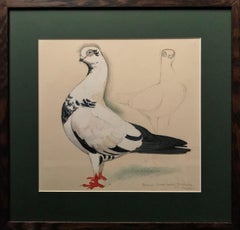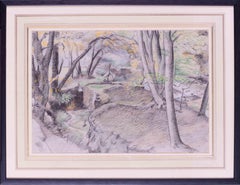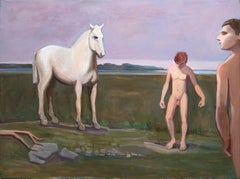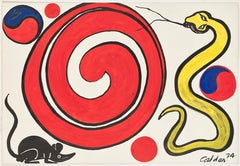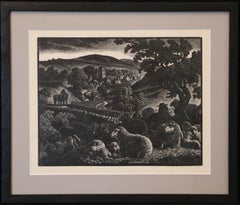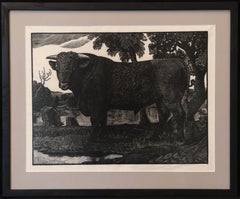Charles Frederick Tunnicliffe Art
to
3
3
2
1
A Berlin short-faced tumber pigeon
By Charles Frederick Tunnicliffe
Located in London, GB
Tunnicliffe is one of the greatest wildlife artists of the 20th Century. A Royal Academician, the RA recently had an exhibition of his work. The present picture was probably executed...
Category
1950s Realist Charles Frederick Tunnicliffe Art
Materials
Pastel, Gouache, Pencil
The Woodland Stream by British artist Charles Frederick Tunnicliffe, 1980
By Charles Frederick Tunnicliffe
Located in Petworth, West Sussex
Charles Frederick Tunnicliffe (British, 1901-1979)
The Woodland Stream
Bears studio stamp `1980’387/24’ (under mount)
Pencil and coloured chalks
10.1/2 x 15 in. (26.7 x 38 cm.)
Category
20th Century Charles Frederick Tunnicliffe Art
Materials
Pastel, Chalk
The Fashion Parade - 20 century animal painting by Charles Frederick Tunnicliffe
By Charles Frederick Tunnicliffe
Located in London, GB
Charles Frederick Tunnicliffe, R.A. (1901-1979)
The fashion parade
signed ‘CF Tunnicliffe’ (lower right)
oil on canvas
25 ⅛ x 30 ¼ in. (63.8 x 76.8 cm.)
frame 30 ⅞ x 36 in. (78.4 x 9...
Category
Mid-20th Century Post-War Charles Frederick Tunnicliffe Art
Materials
Canvas, Oil
Related Items
Horse with Swimmers at Beach
By William Theophilus Brown
Located in Palm Desert, CA
A painting by William Theophilus Brown. "Horse with Swimmers at Beach" is a Post-War figurative painting, acrylic on canvas in a palette of greens and purples by American artist Will...
Category
Late 20th Century Post-War Charles Frederick Tunnicliffe Art
Materials
Canvas, Acrylic
Mickey Mouse
By Alexander Calder
Located in Palm Desert, CA
A painting by Alexander Calder. "Mickey Mouse" is a Post-War abstract painting, gouache and ink on paper in bold colors of reds, blacks, yellows, and oran...
Category
Mid-20th Century Post-War Charles Frederick Tunnicliffe Art
Materials
Ink, Gouache
Portrait of a Newfoundland dog, William Smith, British Painting, 1838, Pets Art
Located in Greven, DE
The works of William Smith were regularly exhibited at the Royal Academy in London between 1813 and 1859. Yet little is known about this artist. He lived in Shropshire and was active...
Category
19th Century Romantic Charles Frederick Tunnicliffe Art
Materials
Canvas, Oil
Antique Dog Portrait of "Mignonne" dated 1876 by Louis Eugène Bourgeois
Located in SANTA FE, NM
Antique Dog Painting of "Mignonne" dated 1876
Louis Eugène Bourgeois (French 1831-1878)
Pastel on cardboard
Signed lower left "E. Bourgeois"
Inscribed upper right "Mignonne."
Rever...
Category
1870s Realist Charles Frederick Tunnicliffe Art
Materials
Pastel, Cardboard
William Jacobs "Urban Scene II", original pastel on paper
By William Jacobs
Located in Glenview, IL
"Urban Scene II" by noted Chicago painter William Jacobs (1897 - 1973) is a pastel on paper created in 1972. The artwork is signed and dated in pencil by t...
Category
1970s American Modern Charles Frederick Tunnicliffe Art
Materials
Pastel
H 5 in W 7 in D 0.01 in
Early 20th Century Spaniel Dog Portrait "Odin" after Edwin Landseer
Located in Soquel, CA
Substantial and period portrait of a beautiful spaniel done in charcoal signed "Lee" on verso, c.1913-1917. Although this is by an unknown artist it is an excellent example of Philadelphia Sketch Club quality drawing. Displayed in a distressed black vintage wood frame with mat. Image, 11"H x 13"W; frame dimensions 17"H x 19"W x 1"D. Phildelphia, PA. Gallery and Frame Makers label on verso. Based on the address and history we know the drawing to be 1913-1917.
Founded by Adolph and George Newman...
Category
1910s Realist Charles Frederick Tunnicliffe Art
Materials
Paper, Charcoal, Gouache
H 17 in W 19 in D 1 in
Cocker Spaniels, pastel of dogs sitting patiently on the front porch
By Barrie Barnett
Located in Charleston, US
Cocker Spaniels, Barrie Barnett, renown pastel artist, astonishes with her skill with pastel. Not a photograph this is an original painting. Two blonde C...
Category
21st Century and Contemporary Realist Charles Frederick Tunnicliffe Art
Materials
Pastel
Hoping for One More Cut
By Natasha Isenhour
Located in Denver, CO
Open field with tree and building
Category
2010s American Impressionist Charles Frederick Tunnicliffe Art
Materials
Pastel
Sugár Andor "Contorted Trees", original pastel on paper
Located in Glenview, IL
"Contorted Trees" by noted Hungarian painter Sugár Andor (1903 - 1944) is a pastel on paper created in 1923. The artwork represents a number of trees, bent by the wind in what appear...
Category
1920s Modern Charles Frederick Tunnicliffe Art
Materials
Pastel
William Jacobs "Windsurfing at Sunset", original pastel on paper
By William Jacobs
Located in Glenview, IL
"Windsurfing at Sunset" by noted Chicago painter William Jacobs (1897 - 1973) is a pastel on paper created in 1970. The artwork is signed and dated in pencil by the artist and was ne...
Category
1970s Modern Charles Frederick Tunnicliffe Art
Materials
Pastel
H 5 in W 7 in D 0.01 in
Imaginary Horse, 2020, acrylic, oil, pastel, canvas, black, blue, pink, abstract
By Macauley Norman
Located in Jersey City, NJ
Imaginary Horse, 2020, acrylic, oil, pastel and graphite on canvas. Spider, web, flower, blue, black, yellow, pink, abstract. Custom framed in a white floating frame
Category
2010s Contemporary Charles Frederick Tunnicliffe Art
Materials
Graphite, Canvas, Pastel, Mixed Media, Oil, Acrylic
Portrait of Julien Prieur as a hunter - Circle of Jean-Baptiste Oudry 1686-1755
By Jean-Baptiste Oudry
Located in PARIS, FR
This portrait depicts us the trusted confidant of the Conflans d'Armentières family. More precisely, Julien Prieur was the fiscal procurator of the Marquisate of Armentières, playing the role of representative of the "public ministry", safeguarding the interests of his lord. His role, one can imagine, was crucial at the death of Michel de Conflans (in 1717) since the latter left an heir, Louis, aged only 6, and a widow, Diane Gabrielle de Jussac, whom some memoirs describe as "a very clever grande dame" . Prieur ensured the smooth running of the family's affairs and it is probably to thank him for his services that Diane Gabrielle had his portrait painted, most probably by a painter close to Jean-Baptiste Oudry.
Julien Prieur appears as he is, middle-aged, with a benevolent look, in his hunting suit. Only his knotted wig links him to the nobility.
Above all, he is depicted as a hunter, a passion that he shared with the Marquis of Armentières. His very young master, Louis, became a first-rate hunter, hunting in the King's entourage, in whose cabinet he died of apoplexy in January 1774. As for the his son, he was one of Louis XVI's closest hunting companions, as numerous souvenirs attest .
1. Some biographical information about the model and the commissioner
While the identity of many 18th century portraits is uncertain, an old label stuck on the reverse of the canvas gives us some precise information on the identity of the model: "Mr. Julien Prieur, homme d’affaires de Mr. le Marquis d'Armentières - Commune of Brécy - Aisne". The label also suggests that it could be his son Louis Prieur living in Rocourt (probably Rocourt-Saint-Martin, a neighbouring municipality of Brécy), born on 30 September 1745, who died on 8 July 1826, but this hypothesis must be rejected in view of the model's clothing. This label probably gives us an indication on the previous owner the owner of this painting; we will see later why it seems likely that this label was affixed between 1826 and 1832.
Brécy is now a municipality in the Aisne County (Hauts-de-France) located between Soissons and Château-Thierry, slightly north of the Paris-Reims axis. It borders the municipalities of Armentières-sur-Ourcq and Rocourt-Saint-Martin. According to Louis Prieur's death certificate, he was in fact born in 1743 and not in 1745 . The age of the model in the painting and the dating of this painting would indicate that Julien Prieur, was probably born at the very end of the 17th century.
In Louise-Marthe de Conflans-Coigny, chatelaine de Brécy , we read that "the Conflans were a family of ancient nobility, which genealogists trace back to the 12th century, when it was said to have come from the house of Brienne. In the 16th and 17th centuries, this family had several illustrations in the profession of arms. [...] Michel de Conflans, [...] belonged to a younger branch of the family, of which Saint-Simon wrote, with his acid soaked pen, that "poor and obscure, they had never left their village, where their house resembled a hut" and elsewhere that they "lived on their rifles and cabbages".
Fortunately for Michel de Conflans, the last representative of the elder branch, Henriette d'Armentières, made him her heir on her death in 1712. It was through her that the land of Armentières and its 14th century castle became part of the estate of this branch, as well as, not far from there, the land of Brécy and the castle of Le Buisson, where the family lived. In the early years of the 18th century, Michel de Conflans was able to push himself into the entourage of the Duke of Orleans, becoming his first gentleman of the chamber. However it was above all his son Louis who restored the family status through his military career.
Born on 23 February 1711, Louis de Conflans, Marquis d'Armentières died of apoplexy on 18 January 1774, in the King's cabinet at Versailles. Appointed lieutenant general in 1746, he received his Marshal of France’s stick in 1768. The Dictionary of French Biography writes of him that "without ever achieving a high command, he appeared with honour in all the wars of his time".
The estates of Armentières and Le Buisson were sequestered during the French Revolution, declared national property and sold at auction (in 1794 and 1795 respectively) after the Marquise d'Armentières, the Marshal's second wife, was beheaded in 1794.
The Château du Buisson (where Michel de Conflans died in 1717) was bought by a granddaughter of the Marshal de Conflans, the Marquise de Coigny, in 1816 and remained in her family after her death in 1832 until the sale of the 1,054 hectares estate in 1866.
The bayonet blows that probably pierced the canvas in three places may well have a revolutionary origin and it is conceivable that the painting, acquired by the Marquise de Coigny from Louis Prieur, Julien's son, after the latter's death, was then restored and given the label specifying the name of the model.
2. Description of the portrait
The painting presents a man in his thirties in his hunting costume. Pictured at mid-body, his face is marked by his life in the open air and characterised by a look of great bonhomie. Holding a rifle under his elbow, he is soberly dressed in a large caramel-coloured jacket, decorated with silver buttons. Presented in a three-quarter view, the model holds a partridge in his right hand. The jacket opens onto a vermilion waistcoat. A green shoulder strap probably holds a powder flask hidden under his arm while a satchel is visible on his belt.
The model is wearing a grey wig, tied at the back with a black ribbon that seems to fly in the wind. This ornament anchors Julien Prieur in his time. "The new King of France, Louis XV, [imposed] a style of smaller wigs for men and the rigorous white or preferably greyish powdering. From the middle of the century men also used a ponytail on the back of the neck, tied with a ribbon, a style that became very popular in all courts."
He stands out against a dark, purplish sky at the end of an autumn day in a soberly sketched forest landscape. The treatment of the sky recalls the influence of Largillière, Oudry's first master.
3. Jean-Baptiste Oudry
Jean-Baptiste Oudry was born on 17 March 1686 in Paris, rue de la Ferronnerie. He began his apprenticeship around 1705-1707 with Nicolas de Largillière, with whom he stayed for five years.
In 1713 Oudry established his "livre de raison" in which he reproduced all his early works in wash drawings up until 1718. During this first period which lasted about 7 years, Oudry produced works of great diversity, both in the genres that the artist tackled and in the artists which influenced him. It has been estimated that he painted about 150 pictures during this period: mainly portraits, but also still lifes and some religious paintings and landscapes.
Of the hundred or so portraits that Oudry is said to have painted during this period, only fifteen have been identified today. A number of those lost portraits are probably still confused with works by Largillière.
First admitted to the Académie de Saint-Luc in 1708, he was then allowed to join the Académie Royale in 1717, and subsequently admitted as a history painter in 1719. This year marks a turning point from which Oudry will assert himself as an animal painter. In 1723 he met Louis Fagon, Intendant of Finances, and the Marquis de Beringhen, the King's first equerry, who became both friends and patrons of the artist, giving him access to royal commissions and enabling him to be appointed as painter of the Royal Tapestry Factory of Beauvais in 1726.
From 1728 onwards, the creation of tapestries became the core of his work, even though at the same time Oudry developed his skill as an illustrator, first for Scarron's Roman Comique and then for La Fontaine’s Fables.
Between 1726 and 1731, Oudry created the decoration of a large drawing room at the château de Condé-en-Brie, about twenty kilometres from Brécy, which has remained in place to this day. This important commission, about which few details are known, is said to have originated with the Countess de Verrüe, a great lady of the French Regency who often stayed at Condé with her friend Jean-François Leriget, Marquis de la Faye, then owner of Condé.
A prolific artist, Oudry fulfilled numerous commissions in parallel with his regular contributions to the Salons, to which he regularly took part until 1753. He suffered a stroke in 1754 and died the following year.
It seems almost certain, in view of the importance of his work, that Oudry supervised a workshop in which several artists were involved, but this point is very poorly documented. Given the geographical proximity of Brécy and Condé-en-Brie, the links between the Armentières family and the Condé patrons, and finally based upon the quality of our portrait, we propose the hypothesis that it was painted by one of the painters who worked with Oudry at Condé.
4. Related artworks: comparison with some other portraits of hunters by Jean-Baptiste Oudry
While Oudry gradually abandoned portraiture from 1720 onwards to devote himself to animal paintings, he seems to have made an exception for hunter portraits, which were often depicted in the company of their hunting dogs. Two examples seem particularly evocative and suggest a dating for our painting around 1730. We will see in a second part why this dating proposal seems relevant.
The first portrait worth mentioning is the presumed portrait of Lieutenant Claude-André Courtin de Crouey, lord of Quatre Fils and Cormeilles-en-Parisis made in 1723, reproduced below. Also presented in a very tight frame, it is interesting for the similarities in the representation of the rifle, and in particular the two metal rivets that are almost identical in our painting.
The painting that seems closest to ours is the presumed portrait of Monsieur...
Category
1730s Old Masters Charles Frederick Tunnicliffe Art
Materials
Canvas, Oil
Previously Available Items
At the day's end
By Charles Frederick Tunnicliffe
Located in London, GB
Charles Frederick Tunnicliffe, R.A. (1901-1979)
At the day’s end
woodcut
image 7 ½ x 9 ⅜ in. (19.1 x 23.8 cm.)
with frame 11 ½ x 13 ⅜ in. (29.2 x 34 cm.)
Category
1940s Charles Frederick Tunnicliffe Art
Materials
Woodcut
A prize shorthorn bull
By Charles Frederick Tunnicliffe
Located in London, GB
Charles Frederick Tunnicliffe, R.A. was one of the greatest animal and ornithological artists of the 20th Century.
A friend and neighbour of fellow Royal Academician Kyffin Williams...
Category
Mid-20th Century Land Charles Frederick Tunnicliffe Art
Materials
Woodcut
An ancient tumber pigeon
By Charles Frederick Tunnicliffe
Located in London, GB
Tunnicliffe is one of the greatest wildlife artists of the 20th Century. A Royal Academician, the RA recently had an exhibition of his work. The present picture was probably executed...
Category
1950s Realist Charles Frederick Tunnicliffe Art
Materials
Gouache, Carbon Pencil
Bertie the Pug - 20th Century British chalk drawing
By Charles Frederick Tunnicliffe
Located in London, GB
CHARLES FREDERICK TUNNICLIFFE, RA (1901-1979)
Bertie the Pug
Bears studio stamp
Chalks heightened with white
17 ¾ by 24 ¼ in., 45 by 62 cm.
Tunnicliffe was born near Macclesfield, Cheshire and was a noted animal and bird painter, illustrator and engraver. He won a scholarship to Macclesfield School of Art, then Manchester School of Art, 1915-21, preceding a Royal Exhibition Scholarship to the Royal College of Art in 1921. A prolific illustrator throughout his life, he is best associated with his work for Henry Williamson’s Tarka the Otter, 1932. He exhibited at the Royal Academy, Fine Art Society, Royal Society of Painter-Etchers and Engravers and elsewhere and was elected a member of the Royal Academy in 1954. Works by him are in many public collections including the British Museum, National Library of Wales and Manchester City Art Gallery.
This work is a study for a same size watercolour (private collection). Tunnicliffe was commissioned to paint Bertie the pug’s portrait...
Category
20th Century Realist Charles Frederick Tunnicliffe Art
Materials
Chalk
Charles Frederick Tunnicliffe art for sale on 1stDibs.
Find a wide variety of authentic Charles Frederick Tunnicliffe art available for sale on 1stDibs. You can also browse by medium to find art by Charles Frederick Tunnicliffe in paint, canvas, crayon and more. Much of the original work by this artist or collective was created during the 20th century and is mostly associated with the post-war style. Not every interior allows for large Charles Frederick Tunnicliffe art, so small editions measuring 11 inches across are available. Customers who are interested in this artist might also find the work of Michael Leonard, William Theophilus Brown, and Morris Louis. Charles Frederick Tunnicliffe art prices can differ depending upon medium, time period and other attributes. On 1stDibs, the price for these items starts at $582 and tops out at $48,930, while the average work can sell for $27,252.
